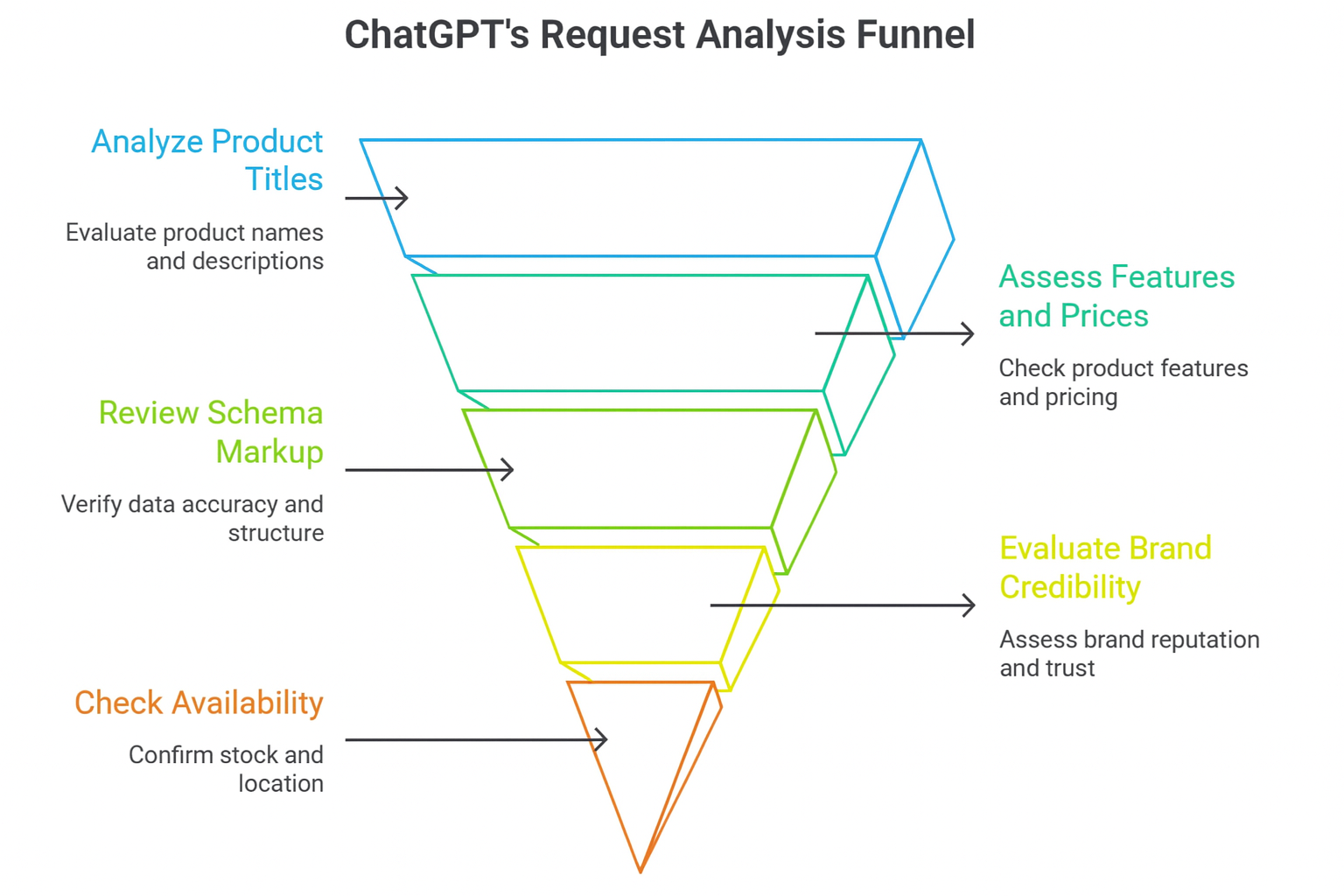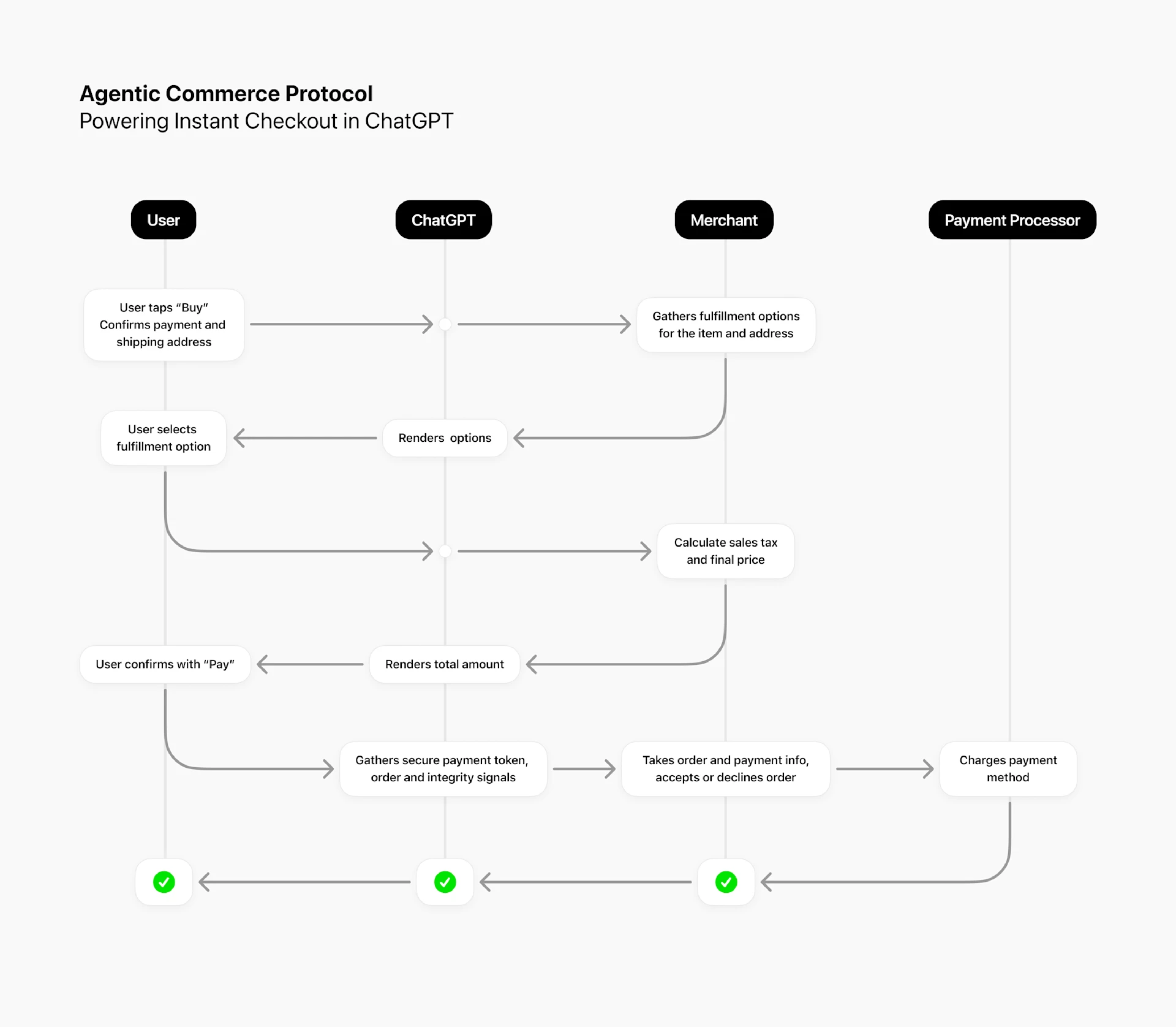-
By Ruchi Pardal

-
~ 12 minutes read
ChatGPT isn’t just a chatbot. It’s becoming a digital storefront. With Instant Checkout powered by OpenAI’s Agentic Commerce Protocol (ACP), users can buy products directly inside ChatGPT.
But will ChatGPT recommend your products to buyers?
For SEO heads and e-commerce leaders, this is a seismic shift. Brands with clean, structured data and AI-optimized product feeds will capture visibility, traffic, and revenue. Brands that lag risk falling behind.
“OpenAI is rolling out a shopping feature in ChatGPT, complete with product picks and buy buttons.” So, users can buy products through ChatGPT, according to Wired.
This new shopping experience began with Etsy sellers and is expanding to Shopify merchants, which is a sign that ChatGPT is getting deeper into the e-commerce game.
With 700 million people using ChatGPT each week, every missed index means lost visibility, traffic, and revenue you simply can’t afford. The opportunity is massive.
Let’s understand how ChatGPT decides which products to recommend, then we’ll break down the new Bill of Materials (BOM) every e-commerce brand needs to stay competitive.
When a shopper types, “wireless headphones with noise cancellation under $200” or “organic skincare set for sensitive skin,” ChatGPT starts analyzing that request.
It evaluates:

If your data is clean, clear, and structured, ChatGPT can confidently recommend your product.
Structured schema (JSON-LD) is the foundation of AI discoverability. A clean schema allows ChatGPT to confidently recommend your product.
Here’s a JSON-LD Schema markup example you can use for the product page on our ecommerce website. It includes key details: product name, price, description, availability, and reviews. Customize the values for each product:
<script type=”application/ld+json”>
{
“@context”: “https://schema.org/”,
“@type”: “Product”,
“name”: “Example Product Name”,
“image”: [
“https://www.example.com/images/product-image1.jpg”,
“https://www.example.com/images/product-image2.jpg”
],
“description”: “This is a detailed description of the product, highlighting its features and benefits.”,
“sku”: “EX12345”,
“mpn”: “MPN12345”,
“brand”: {
“@type”: “Brand”,
“name”: “Example Brand Name”
},
“offers”: {
“@type”: “Offer”,
“url”: “https://www.example.com/product-page”,
“priceCurrency”: “USD”,
“price”: “49.99”,
“priceValidUntil”: “2025-12-31”,
“itemCondition”: “https://schema.org/NewCondition”,
“availability”: “https://schema.org/InStock”
},
“aggregateRating”: {
“@type”: “AggregateRating”,
“ratingValue”: “4.7”,
“reviewCount”: “128”
},
“review”: [
{
“@type”: “Review”,
“author”: {
“@type”: “Person”,
“name”: “Jane Doe”
},
“datePublished”: “2025-09-10”,
“reviewBody”: “Excellent product, fast shipping, and great customer service!”,
“reviewRating”: {
“@type”: “Rating”,
“ratingValue”: “5”,
“bestRating”: “5”
}
},
{
“@type”: “Review”,
“author”: {
“@type”: “Person”,
“name”: “John Smith”
},
“datePublished”: “2025-09-05”,
“reviewBody”: “Good quality, but packaging could be improved.”,
“reviewRating”: {
“@type”: “Rating”,
“ratingValue”: “4”,
“bestRating”: “5”
}
}
]
}
</script>
When updating schema markup, focus on core elements:
Validate it using Google’s Rich Results Tool. One clear schema section is better than multiple conflicting sources.
A product feed is a structured file that organizes your product information and shares it with platforms like Google Merchant Center, Shopify, Etsy, and others. It contains details such as product titles, prices, availability, images, and links, powering ChatGPT’s shopping engine. You must update it regularly.
See the data in the image below that shows the best practices for product feeds:

Match titles and meta tags across the site and feed. Include canonical URLs and validate with Merchant Center Feed Diagnostics.
AI systems, like ChatGPT, rely on these feeds from major platforms to decide which products to suggest.
Want to add your product feed directly to ChatGPT? Read this.
However, as an e-commerce SEO specialist, you must be aware of common feed problems and solutions to resolve them:
| Problems | Why It Happens | Solution |
| Price Mismatch | Feed hasn’t updated, or sync delay | Set up daily or real-time feed updates. Use a consistent pricing source. |
| Incorrect Availability | Inventory updates on site, but the feed lags | Sync stock levels in real-time whenever possible. Double-check before campaigns. |
| Truncated or Wrong Title | Feed title differs from on-page H1/meta | Align feed titles with your page’s H1/meta. Keep naming consistent. |
| Wrong Image | Feed defaults to the first gallery image | Set the main product image as primary in both CMS and feed. |
| Missing Reviews | Reviews hidden via JS or not in the schema | Add Review and AggregateRating schema directly in HTML. |
| Conflicting Schema | Multiple plugins or apps overwrite each other | Stick to a single schema source and validate with Schema.org or the Google Rich Results test. |
Automation can handle most updates. But do manual checks to fix any errors.
Ensure that your website is accessible to AI crawlers. Usually, two common blockers restrict crawler’s way.
Run Test for JavaScript-loaded content:
Better, use server-side rendering (SSR) for all critical content instead of relying solely on JavaScript, as some bots may struggle to understand it.
If your product’s details, prices, or images vanish when JavaScript is disabled in your browser, they aren’t in the raw HTML.
How to check if the content only loads via JavaScript:

Under Content, find JavaScript and switch it to “Don’t allow sites to use JavaScript.”
Refresh the product page and check if key details disappear. If the product details vanish, they’re only loading through JavaScript.
Review your robots.txt file:
This file controls which bots can crawl your site.
Solution: Update the file to allow AI bots to access your pages.

AI weighs credible brands backed by real trust signals before recommending products. That means you need to send strong, consistent trust signals across the web.
How to Do That:

The stronger your brand authority, the more likely ChatGPT will recommend your products.
ChatGPT doesn’t rely on keywords the same way Google does. Instead, it matches products to the natural language people use when they type or speak prompts.
If your product copy sounds robotic or doesn’t reflect how real shoppers ask questions, your products may never appear in AI-powered shopping results. The trick is to mirror the way customers actually talk.
For example, instead of “Noise-Cancelling Headphones Model 700X”
Write: “Wireless Noise-Cancelling Headphones, Perfect for Travel and Remote Work”
How to Identify Customer Language
Stop guessing. Use the tools below to see the exact phrases your buyers are searching for.

Focus on how shoppers talk, not just how search engines crawl. It is advisable to use conversational modifiers:
Tools like AnswerThePublic and Semrush AI SEO Toolkit show real conversational prompts that drive AI recommendations.
AI systems and shoppers both want clarity. So, place your product’s core value above the fold, then reinforce it through:
Placing it near the top makes it easy for ChatGPT (and shoppers) to immediately grasp what the product is and why it stands out from others.
Take the Lenovo page as an example. They have highlighted USP (USB Wired Stereo Headset) above the fold.

But simply stating your value once isn’t enough. The rest of the page needs to echo and reinforce that promise, creating a consistent story from start to finish.
Every element (features, benefits, reviews, specs, and even images) should back up your main value.

This helps AI build a complete understanding of your product while giving buyers confidence that you deliver on what you promise.
What does it mean?
With the Agentic Commerce Protocol (ACP), ChatGPT enables native purchases. Users can browse, pay, and confirm without leaving ChatGPT.
Let’s assume:
A shopper finds your product inside ChatGPT, confirms the details, pays, and completes their order. Everything without leaving the chat window.
That’s exactly what Instant Checkout makes possible.
For everyone else, there’s a bit of setup involved. You need to connect through OpenAI’s Agentic Commerce Protocol (ACP).

Here’s the roadmap:
Fill out OpenAI’s merchant application form to get noticed. Merchants are being onboarded gradually.

Others can use Stripe’s Shared Payment Token API or Delegated Payments Spec. No need to switch providers.
Even if Instant Checkout isn’t live for your platform yet, start preparing now. Clean product data, reliable feeds, and a flexible backend will help you hit the ground running once OpenAI expands access.
Showing up in ChatGPT Shopping is only the first step. What really matters is knowing how well your products perform once they appear.
Start by monitoring traffic data. OpenAI makes this easier with a built-in UTM parameter:
utm_source=chatgpt.com
This tag is automatically added to outbound links from ChatGPT, so you can track them inside Google Analytics.
Create a custom segment to see how much traffic comes directly from ChatGPT and how it behaves once it lands on your site.
Look for insights such as:
Note that not all traffic is traceable. Some users might read about your product in ChatGPT but then search for your brand on Google instead of clicking the link. So, watch for spikes in direct visits or branded searches, as another signal of LLM-driven visibility.
Traffic analysis shows you what happens after the click. To get the full picture, you also need to understand what prompts trigger your products to appear in the first place.
The e-commerce search landscape has changed and ChatGPT is the new digital storefront.
Your Bill of Materials (BOM) now includes not just SKUs and prices, but structured data, feed integrity, and conversational SEO. Brands that optimize today will dominate tomorrow’s AI shopping experiences.
The table below shows the key actions and outcomes for making your e-commerce SEO AI-ready for ChatGPT Instant Checkout.
| Category | Core Action | Outcome |
| Schema | Add detailed JSON-LD | Better AI comprehension |
| Product Feed | Keep synced and verified | Real-time accuracy |
| Site Crawlability | Allow GPTBot + SSR content | Visibility in ChatGPT |
| Trust | Build brand authority | AI recommends your products |
| Content | Write in natural language | Align with AI prompts |
| Checkout | Enable ACP integration | Sell directly in ChatGPT |
| Analytics | Track “chatgpt.com” traffic | Measure AI-driven ROI |
Consider these steps like reorganizing your digital shelves before customers arrive. The only difference now is that your store is on ChatGPT.
Ready to prepare your store for AI-powered shopping? Request your Custom BOM + AI Shopping Checklist today and get a full technical audit covering your site’s feeds, server setup, and checkout flow, so your products appear where shoppers are now searching: inside ChatGPT.